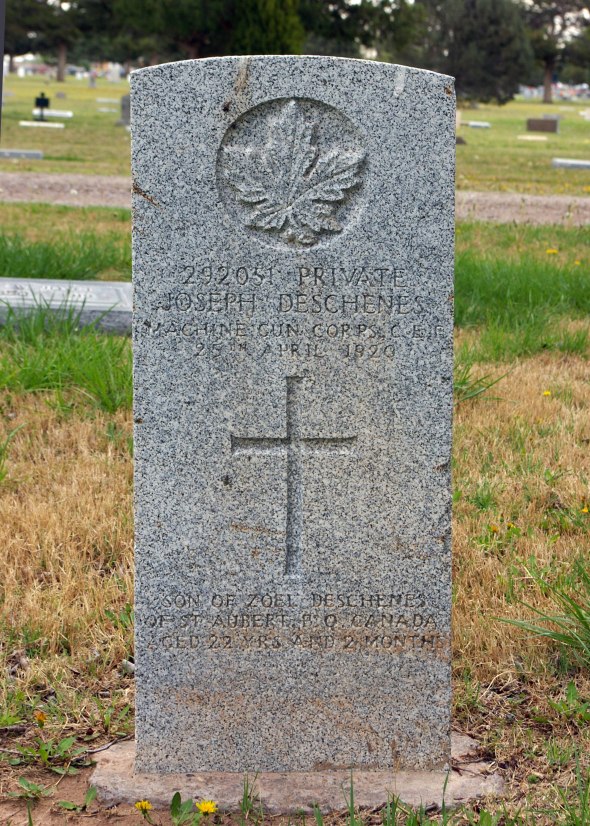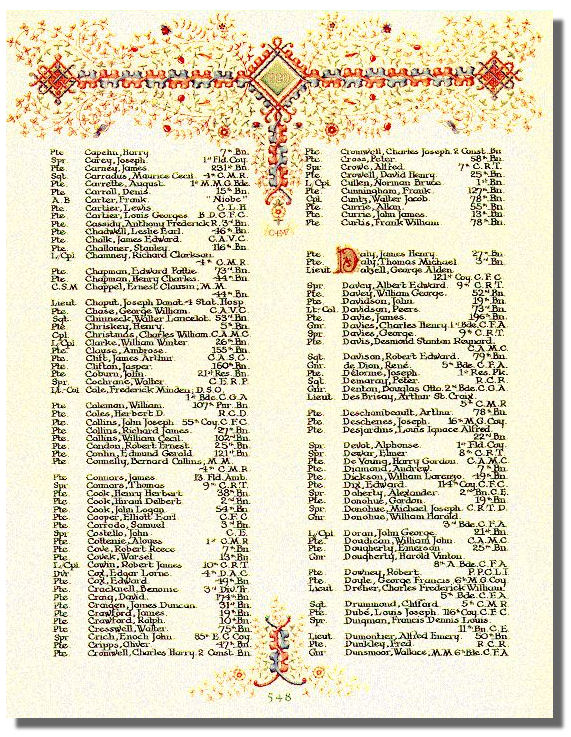This is one of two essays about the First World War casualties commemorated by the Commonwealth War Graves Commission in New Mexico.

Joseph Honoré Deschenes was a French-Canadian born on 10 February 1898 at St. Aubert, Quebec the fourth of the nine children of Zoël and Clare Deschenes.[1] At the time of his enlistment he was working as a labourer in Letellier, a small Francophone community in Manitoba.
He enlisted on 20 December 1915 in Morris, Manitoba for service with the Canadian Expeditionary Force. When he enlisted he gave his year of birth as 1897, implying that he was two months short of his 19th birthday. He joined 222nd Battalion at Winnipeg and was allocated the number 292051. After almost a year training in Canada, the men of the Battalion sailed for England on 13 November 1916, arriving a week later. The Battalion was not to see action, however, and its men were drafted to other units.
Private Deschenes was posted to the 44th Battalion and arrived at the Canadian Base Depot in France on 29 December. Sent forward from Le Havre, Deschenes, and the other 59 men of this reinforcement draft, joined the 44th Battalion in 10th Brigade, 4th Canadian Division near Carency on 19 January 1917.
For the next three months the battalions of 10th Brigade alternated in and out of the line in this area, occasionally taking their turn in reserve billets. On 3 February the Battalion launched a successful raid against the enemy line near Kennedy Crater, west of Givenchy—the result was 17 enemy soldiers and one machine gun captured. Ten days later a very large raid was carried out, led by Lieutenant Colonel R D Davies,[2] Commanding officer of 44th Battalion, which was even more successful, although at a cost of eight killed, 15 missing and 130 wounded from a raiding strength of 870. It is not known if Private Deschenes took part in either of these. Such raids continued across the Canadian Corps’ front with increasing frequency—including another large raid by men of the 44th and 47th Battalions on 15/16 March—until the launch of the attack on Vimy Ridge on 9 April, the opening phase of the Battle of Arras.
During the early phases of the attack, 44th Battalion in 10th Brigade was to capture the ‘Pimple’, a reinforced German position on the northern flank but this order was rescinded. The next afternoon, 10 April, the Battalion attacked instead to establish an outpost line on the left flank of the Corps attack; an operation successfully conducted at a cost of 15 killed, 75 wounded and 10 missing. On 12 April the Battalion finally attacked the Pimple, the final objective of the northern flank. Again, the attack was most successful and the Battalion was relieved by 1st Battalion, The Devonshire Regiment at 9.30pm that night, having suffered a further 119 men killed, wounded and missing. Fighting continued on the ridge and farther forward for some weeks as positions were consolidated and German attacks repelled. Finally, on 26 June the Battalion moved into reserve at Chateau de la Haie and on 3 July moved to Coupigny where it trained and integrated reinforcements to replace those lost in the preceding months.
On 9 August Private Deschenes was granted leave in Paris and after that, on 21 August, he transferred to the Canadian Machine Gun Corps and was posted to 16th Machine Gun Company. The Company was the fourth machine gun company of 4th Division, formed in December 1916, and with the other companies of the Division, made up 4th Canadian Divisional Machine Gun Battalion.[3]
Private Deschenes’ final action with the Canadian Corps was to be in the mire of Flanders during the Third Battle of Ypres. Having relived II Anzac Corps on 18 October, the Canadian Corps launched a series of attacks in atrocious conditions beginning on 26 October, which became known as the Second Battle of Passchendaele, the final phase of the larger Battle. By the middle of November 1917, the consolidation operations by the Canadian Corps at Tyne Cot were complete and the Corps began to be relieved by VIII Corps.[4]

On the night of 17/18 November, No. 4 Battery (made up of guns from 16th Company) was severely shelled and gassed. Ironically this was after moving position to escape earlier shelling. Deschenes was one of eight casualties suffered by the Battery before they were withdrawn from their position—with 10th Machine Gun Company they were ‘the last Canadians to leave Passchendaele Ridge’.[5] A shell fragment had pierced Deschenes’ respirator and gas injured his eyes and lungs; he also suffered minor gas burns on his left arm and leg.
Deschenes was evacuated through the casualty chain to No. 83 General Hospital at Boulogne, where he arrived on 2 January 1918. His eyes and the minor burns healed quickly but he was left with a persistent cough. He was treated in Boulogne for broncho-pneumonia until he was evacuated to hospital in England on 29 January. After short periods in various hospitals he was admitted to the Manor War Hospital in Epsom on 23 February. He was examined there in July and it was recommended that he be sent back to Canada; at that stage he was clear of tuberculosis. Private Deschenes sailed from Liverpool on the hospital ship SS Araguaya in October 1918 arriving in Halifax at the end of the month.
On his arrival in Canada he was taken on strength of the Hospital Section in Quebec and sent on leave for 14 days—he over stayed his leave by six days and forfeit seven days’ pay as a result. He was then admitted to Savard Park Military Convalescent Hospital in Quebec, where he remained until he was discharged on 23 January 1919 and became the responsibility of the Invalided Soldiers’ Commission.[6]
The detail of his movements after that are not completely known but it is clear that he developed tuberculosis and spent some time ‘chasing the cure’ in Fern Hill Sanatorium in Edgewater, Colorado, and it appears that he then moved farther south, to St Mary’s Hospital, in Roswell, New Mexico, to take advantage of the state’s warm dry air. He died there of tuberculosis on 25 April 1920 and was buried in South Park Cemetery.[7]
 He is commemorated on page 548 of the Canadian First World War Book of Remembrance; that page is displayed on 22 November.
He is commemorated on page 548 of the Canadian First World War Book of Remembrance; that page is displayed on 22 November.
Sources:
War diary, 44th Battalion. Library and Archives Canada.
War diary, 16th Canadian Machine Company. Library and Archives Canada.
Lewis, N O. (2008). The Lungers and their Legacy: Chasing the Cure in New Mexico. El Palacio Magazine, Winter 2008.
1. (Back) Zoël (some records show ‘Zoelle’) Deschenes (28 January 1860-14 February 1930) married Clara Bois (20 June 1861-3 August 1919) on 19 January 1885 in Salem, Massachusetts: Marie Alexina (8 June 1887-13 May 1888); Marie Jeanne (2 June 1889-8 April 1969); David Zoël (29 July 1890-10 July 1968); Joseph Alphonse Uldéric (14 March 1892-NK); Rosa (3 July 1893-19 January 1942); Rose Eva (later St. Pierre) (c1895-c1990); Marie Anne (later Theriault) (1 August 1899-NK); Marie Florida (April 1900-NK); Alphonse (May 1901-NK); and Joseph Herménégilde (10 September 1903-14 April 1980).
2. (Back) Lieutenant Colonel Reginald Danbury Davies DSO**.
3. (Back) Comprising the 10th, 11th, 12th, and 16th Canadian Machine Gun Companies, it was redesignated as 4th Canadian Machine Gun Battalion in March 1918.
4. (Back) For a full account of the actions by the Canadian Machine Gun Corps during the Battle of Passchendaele see: Grafton, C S. (1938). The Canadian Emma Gees: A History of the Canadian Machine Gun Corps. London: Canadian Machine Gun Corps Association.
5. (Back) Grafton. Op. Cit. p 95.
6. (Back) Upon discharge all officers and soldiers passed to the control of the Commission if they required ‘medical treatment on account of their suffering from tuberculosis, epilepsy, paralysis or other diseases likely to be of long duration or incurable, or on account of their being mentally deficient or insane’.
7. (Back) Lot 836. Block 28.



